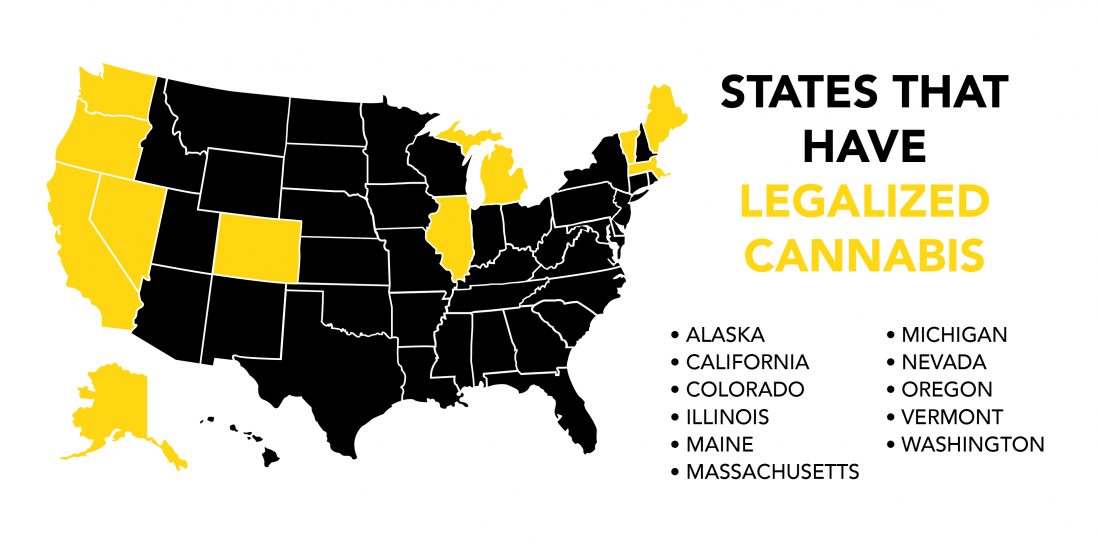Dank. Loud. Potent.
Those are just a few of the evocative words that pop-up often when describing one of marijuana’s defining characteristics: its smell. The odor is something weed connoisseurs value, and one of the plant’s defining characteristics that sites like Leafly tend to emphasize.
But researchers have recently found that the plant’s smell could be responsible for a decrease in air quality.
Terpenes are a type of organic compound that give cannabis its pungent smell. Terpenes help cannabis repel predators and attract pollinators. But they can also cause air pollution, a study by a team of researchers found. The team – which includes scientists from the University of North Carolina, the University of Colorado, Lancaster University in the UK, and the National Oceanic and Atmospheric Administration – concluded that cannabis can degrade the environment by creating more ozone.
Terpenes are classified as volatile organic compounds, or VOCs. When VOCs are combined with other compounds in the air, it creates ozone, a powerful greenhouse gas and a major component of global warming. VOCs can be found in consumer products such as paints, cleaners, disinfectants and pesticides – and, apparently, marijuana.
Jane Read, a geography associate professor at Syracuse University, explained that VOCs can affect air quality indoors and outdoors as well as the quality of the atmosphere.
“In the atmosphere, they play a role in ozone formation, which is a pollutant in the troposphere, and can contribute to acid deposition and smog,” Read said. “VOCs, ozone, acid deposition and smog all have major health effects to humans and other organisms.”
The study of terpenes polluting potential found that cannabis plants can create significant VOC emissions each year. It also found that various strains can release different levels of VOCs. The study measured the levels of four different strains of cannabis: “Rockstar Kush,” “Elephant Purple,” “Lemon Wheel,” and “Critical Mass.” Over time, the study showed that each strain emitted varying levels of terpenes such as myrcene.
While this might be alarming for climate change activists, cannabis-related business owners are capitalizing on terpenes’ marketing potential, as well as some potential health-related benefits of the terpenes compounds.
Some companies and researchers say terpenes can enhance the healing effects of cannabis, leading to claims that terpenes can enhance the relaxing effects of marijuana in the same way that the aroma of lavender enhances its healing properties.
This is called the entourage effect, in which various compounds such as THC and CBD work together to give cannabis its medicinal effects. For example, some say that myrcene can have anti-inflammatory and pain-relieving effects when found in certain strains, while the terpene limonene is thought to boost one’s energy levels.
But there is still no hard evidence that proves the entourage effect is real. In an interview with Scientific American, some researchers said they believe it works while others say that its effectiveness is purely a placebo.
“We’ve done a lot of focus groups, data collection and analysis since we’ve started, and 80 or 85 percent of people fall right into the effect we say they will get,” said Chris Emerson, a chemist and the co-founder of a cannabis vaporizer company called Level Blends told Scientific American.
Other scientists believe the claims are more about marketing. Margaret Haney, a cannabis researcher and neurobiologist at Columbia University, told Scientific American that she believes that the entourage effect should be put under more scrutiny.
“The lay public has really taken on the notion of the entourage effect, but there’s not a lot of data,” she told the Scientific American. “The cannabis field can say anything, and it does. I’m not against marijuana.
“I want to study it carefully. We know it can affect pain and appetite but the large majority of what’s being said is driven by anecdotal marketing.”
The cannabis plant is native to the Indian-subcontinent and requires warm temperatures and high-light intensity to thrive, according to the researchers studying the polluting effects of terpenes. Because those are not the conditions in many pot-legal states like Colorado, cannabis farmers often use greenhouses to ensure high-quality yields. Greenhouses also allow for year-round operations and security.
Pravin Mehta, owner of Knarich Family Farms, an industrial hemp farm in Mount Vision, New York , has been conducting research through New York’s Agriculture and Markets Department. While he currently grows his plants outside, he says greenhouses would be preferable.
“We can only get one crop harvest a year outdoors,” Mehta said. “In the greenhouses, we can get at least two to three crop harvests a year.”







